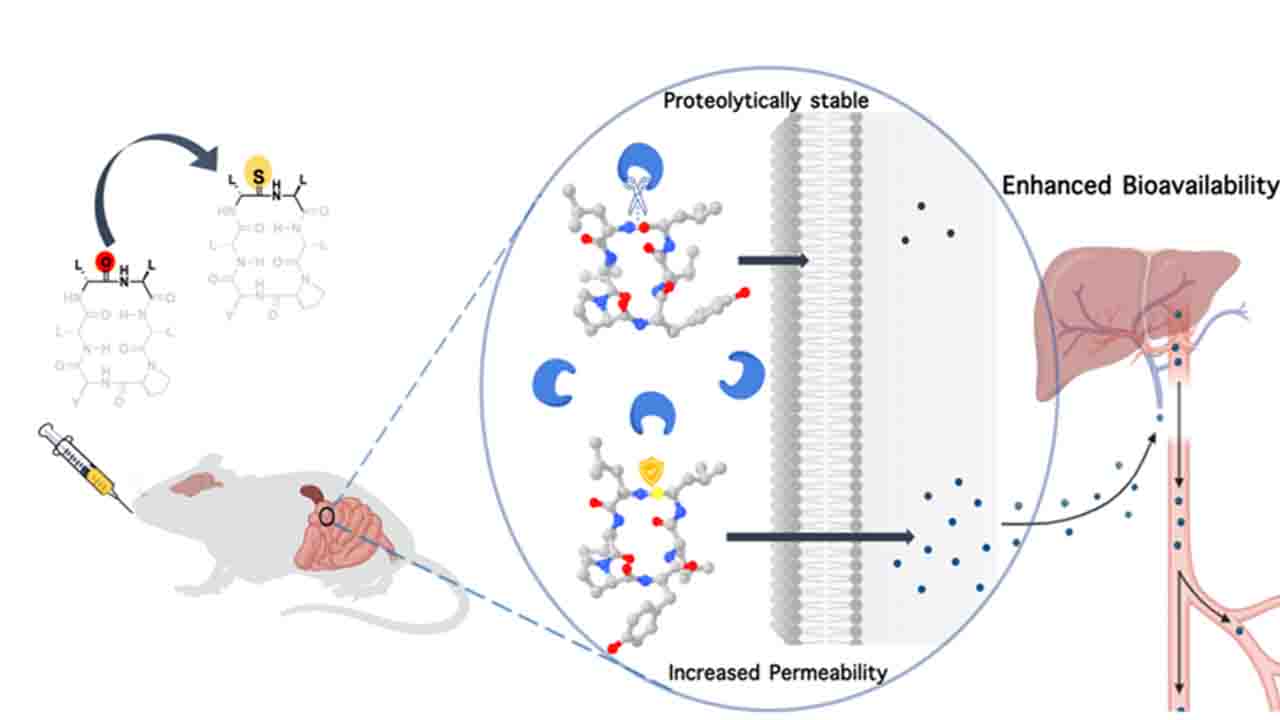Science & Technology, India (Commonwealth Union) – The efficacy of any drug molecule hinges on its ability to interact effectively with the internal environment of our body. Its pharmacokinetic (PK) properties determine its success in evading degrading enzymes during its journey through the digestive system or bloodstream, traversing biological barriers like cell membranes, and ultimately reaching the intended target.
In a study featured in Nature Communications, scientists from the Molecular Biophysics Unit (MBU) at the Indian Institute of Science (IISc) present an innovative approach to enhance the pharmacokinetic properties of “macrocyclic peptides,” which are highly sought after by pharmaceutical industries worldwide. Collaborating with Anthem Biosciences, the IISc team has demonstrated that a simple substitution of a single atom – replacing oxygen with sulfur – in the macrocyclic peptide’s backbone can render it more resistant to digestive enzymes and enhance its ability to pass through cell membranes, thereby increasing its bioavailability.
The majority of today’s medications are comprised of small molecules administered orally in pill form. While larger molecules like monoclonal antibodies are more specific and effective, they typically require injection. Hence, scientists have turned their attention to macrocyclic peptides – sequences of amino acid residues connected by amide bonds, engineered to create circular structures. These compounds represent a fusion of the advantageous characteristics found in both small and large pharmaceutical molecules.
Researchers pointed out that however, similar to any protein, macrocyclic peptides have increased susceptibility to digestive enzymes. Further they found it difficult to cross cell membranes that consist of lipids, due to them being water-loving molecules. The amide (CO-NH) bonds in these peptides engage with water molecules in the vicinity through relatively weaker bonds known as hydrogen bonds. “For peptides to pass through a lipid membrane, they must reduce their hydrogen bonding with water. They must become a little more oil-loving (lipophilic),” added Jayanta Chatterjee, Professor at MBU who is also corresponding author of the study. “Currently there are no concrete methods available apart from N-methylation to improve the pharmacokinetic properties of macrocyclic peptides,” he added.
Pritha Ghosh, a former PhD student at MBU and the primary author, elucidates that the prevailing N-methylation strategy involves the replacement of a hydrogen atom in the amide bond with a methyl group. This alteration impedes the formation of hydrogen bonds between the nitrogen atom in the amide bond and the surrounding water, facilitating the peptide’s passage through the lipid membrane. However, this modification has demonstrated an adverse effect on the peptide’s binding to its target, rendering it excessively flexible and less specific. In a bid to surmount this limitation, Chatterjee and his team opted to redirect their focus towards the oxygen atom within the amide bond. This oxygen atom is known to engage with two water molecules via hydrogen bonds. Through the use of chemically synthesized cyclic peptides, they established that replacing this oxygen atom with sulfur significantly enhances the peptide’s lipophilicity, thereby increasing its permeability through the lipid membrane. Additionally, this alteration rendered the peptide less vulnerable to digestive enzymes, as these enzymes typically target the oxygen atom in the amide bond, which has now been replaced with sulfur.
To assess whether such a modified compound could retain its biological function, the team employed a truncated version of somatostatin, a hormone produced by the pancreas that inhibits growth hormone in the body. They substituted the oxygen atom of an amide/peptide bond with sulfur. Remarkably, the team discovered that when injected beneath the skin of model animals, the modified somatostatin not only exhibited a prolonged presence in the bloodstream compared to the unmodified version but also effectively suppressed the growth hormone.
“[After somatostatin], our lab continues to work with other biologically active molecules. Oxygen-to-sulphur modifications may be used in combination with other strategies … more than one substitution may give better results. We can use this technology to make peptides with better pharmacological properties,” added Ghosh.








